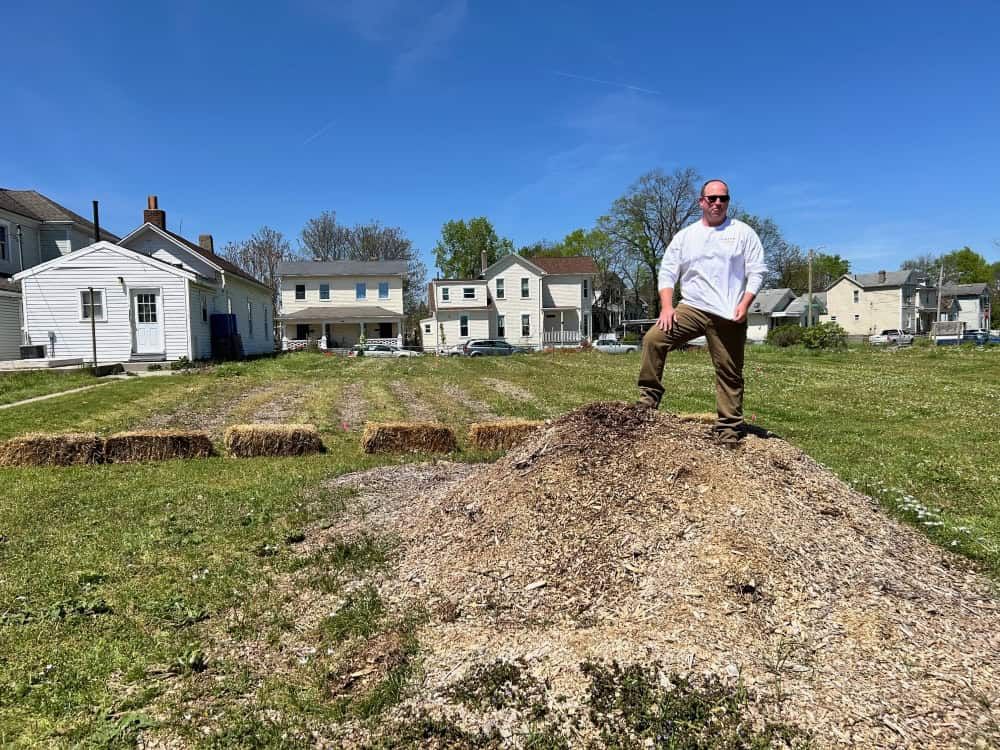The sun beats down unforgivingly on a humid July day. Bruce Kidney stands, his hands full of fresh vegetables, waiting for the door to open at a home in Riverdale. When it does, he’ll offer the produce. But he’ll have to get creative in how he does it.
The vegetables came from the Unity Garden, at 108 Neal Avenue, directly behind Kettering Health Dayton.
Sitting on property owned by the medical center, the garden is in a community heavily populated by African refugees who primarily speak Kinyarwanda or Swahili. Catholic Social Services of the Miami Valley helps place them in the area as part of its refugee settlement program.
And the area is stuck in a food desert.
Caring for patients and plants
Day-to-day, Bruce serves patients as an RN in the Post-anesthesia Care Unit at Kettering Health Dayton. But he also has a passion for food. He even has a culinary arts degree—and is an avid gardener. He’d always dreamt of starting a community garden.
In his previous role at Southview Medical Center (now Kettering Health Washington Township), Bruce worked with a doctor who traveled to Africa with Doctors Without Borders.
“I had two young children. I couldn’t run off to Africa to help her volunteer,” he said.
But Bruce was inspired to find a way to connect his passions closer to home. “That sparked my interest in the refugees and helping them get to a better place.”
When he learned the neighborhoods surrounding Kettering Health Dayton are in a food desert, it all clicked.
Growing together
Today, he wears many hats as the manager of the Unity Garden, with support from volunteers who help weed, plant, and cultivate the plant beds.
The community garden provides a space for residents to grow and harvest fresh vegetables for their households. Bruce supports them with donated plants and nutrients and helping till. He also manages a 50-by-30-foot garden filled with donated plants as well as traditional African vegetables. He worked with the refugees to learn their greatest food needs and now grows specific varieties of eggplant, beans, squash (they call pumpkin), and amaranth, which they use for its leaves instead of the grain.
When it’s time to harvest, Bruce goes door-to-door, handing out the produce and meeting neighbors. He also spreads the word about the garden.
When he’s able to communicate with the residents, that is.
He often looks to their children, who typically speak some English, for help. He sometimes uses a translator app and has even gotten help from a co-worker who’s also a refugee. Despite the language barrier, the refugees are grateful, and Bruce feels fulfilled.
“It’s a blessing to provide fresh and nutritious vegetables at no cost to the community surrounding the hospital who have no other options nearby.”
Cultivating community
The Unity Garden spans a total of eight lots, more than half of which haven’t been tapped into yet.
Before the garden could flourish, though, it needed compost. Bruce worked with Dorothy Lane Market in Oakwood, who agreed to give their food waste to the garden. “The Oakwood community can also add to those bins,” he said. “And I bring them down to the garden and manage compost to help the quality of the soil.”
Over the last year, they’ve diverted 10,000 pounds of food waste from the landfill.
While Bruce said a challenge is the lack of running water on-site, his goal is to primarily use rainwater for the garden. Enterprise Roofing donated a metal roof and gutter system to help collect up to 1,400 gallons of rainwater.
Bruce also worked with Nutrition Services at Kettering Health Dayton, who collect and donate their 4.5-gallon food-grade containers—which they use to switch the oil in their fryers—to help water the garden.
A green future
Bruce could talk endlessly about the Unity Garden. The passion in his voice is palpable. And his vision for its future is full of growth: using it as an educational space for local students, adding a mini orchard, and wrapping it in native plants to encourage pollinators.
Bruce also worked with one of Siebenthaler’s landscape architects who spent nearly 10 hours surveying the lots, then designed a blueprint to optimize the garden space.
“I love it. I love it,” Bruce emphasized. “If I’m not at Kettering Health Dayton working, that’s what I’m doing. I’m working on this project.” Until his wife, Melissa, says their own projects, like mowing their lawn, need attention.
This year, Bruce is focused on a few major projects: assembling a 20-by-32-foot donated greenhouse to grow produce year-round, solidifying the rainwater collection system, and mounting a mural painted by a local artist, John Lehman.
He’s been impressed with the level of interest and support from the community. “That’s been one of the most amazing things about it,” he said. “Everybody wants to help.”
Bruce has worked for Kettering Health for nearly 20 years—much of that on the frontlines. On tough days, he’s grateful to escape to the garden and feel the sun on his skin and dirt on his hands; to see the growth he and the community have created. And to reconnect with the Earth.










